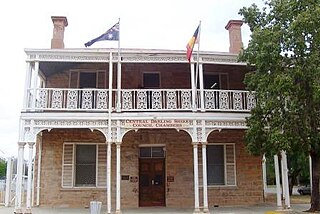Nukunu are an indigenous Australian people of South Australia, living around the Spencer Gulf which since British settlement has developed to contain the cities of Port Pirie and Port Augusta.

The Nari-Nari are an Indigenous Australian group in the Riverina region of New South Wales, Australia. The Nari-Nari are believed by historians to have formed in the Balranald area on the lower Murrumbidgee River, from the amalgamation of a number of groups in neighbouring areas such as the Wiradjuri and the Watiwati. The Nari-Nari share a western border with the Muthi Muthi tribe.

The Darling language, or Paakantyi (Baagandji), is a nearly extinct Australian Aboriginal language spoken along the Darling River in New South Wales from present-day Bourke to Wentworth and including much of the back country around the Paroo River and Broken Hill. The people's and language name refers to the Paaka with the suffix -ntyi meaning 'belonging to',

The Wilyakali or Wiljaali are an Australian aboriginal tribal group of the Darling River basin in Far West New South Wales, Australia. Their traditional lands centred on the towns of Broken Hill and Silverton and surrounding country. Today the Wilyakali people of Broken Hill are still the main Aboriginal group living in Broken Hill.

The Ngarigo are an indigenous Australian people of southeast New South Wales, whose lands also extended around the present border with Victoria.

The Muthi Muthi people, also written Matimati are an Indigenous Australians people whose traditional lands are located in the Northern Riverina and Far West regions of New South Wales.

The Kureinji, otherwise known as the Keramin, are an Aboriginal group whose traditional lands are located in the Northern Riverina of southwest New South Wales, Australia.

The Dadi Dadi or Tatitati are an Australian Aboriginal tribe whose traditional lands are located along the southern banks of the Murray River in Victoria Australia.
The Maraura people are an Aboriginal group whose traditional lands are located in Far West New South Wales and South Australia, Australia.
The Anēwan, also written Anaiwan/Anaywan, are the traditional owners of the land around Armidale and the New England tableland in New South Wales.
The Barindji, also written Parrintyi, are an indigenous Australian people of the state of New South Wales. They are to be neatly distinguished from the Paaruntyi, who spoke a similar language but whom they called the spitting people.
The Jitajita, otherwise spelt Yitayita, are an indigenous Australian people of southern New South Wales.
The Malyangapa are an indigenous Australian people who lived in the far western areas of the state of New South Wales.
The Ngurunta or Runda are believed to have been an indigenous Australian people of the state of South Australia located immediately west of Lake Frome.
The Yardliyawara otherwise known as the Jadliaura were an indigenous Australian people of South Australia.
The Wakabunga are an indigenous Australian people of the state of Queensland.
The Ngiyampaa also known as the Ngemba, are an indigenous Australian people of the state of New South Wales.
The Wanjiwalku were an indigenous Australian people of the state of New South Wales.
The Paaruntyi are an indigenous Australian people of the state of New South Wales. They are not to be confused with the Parrintyi.













